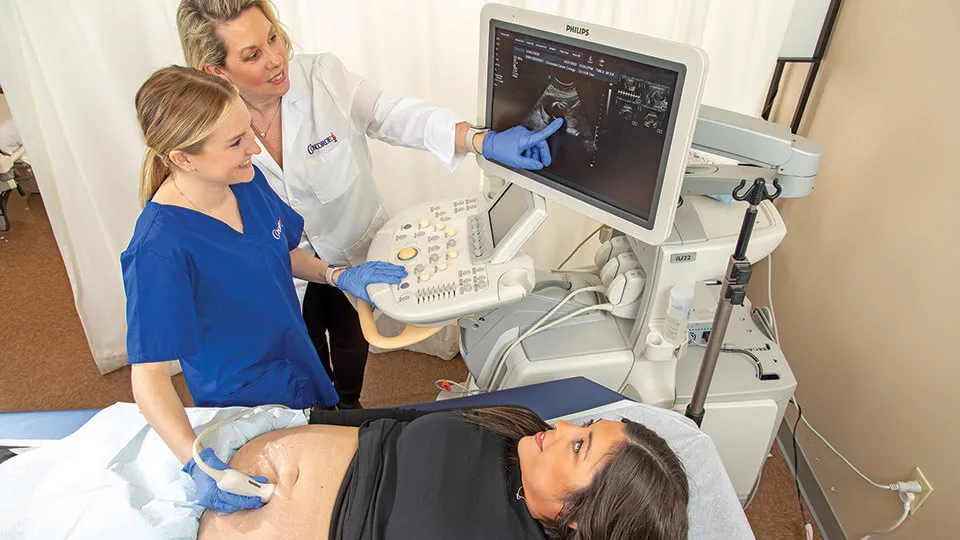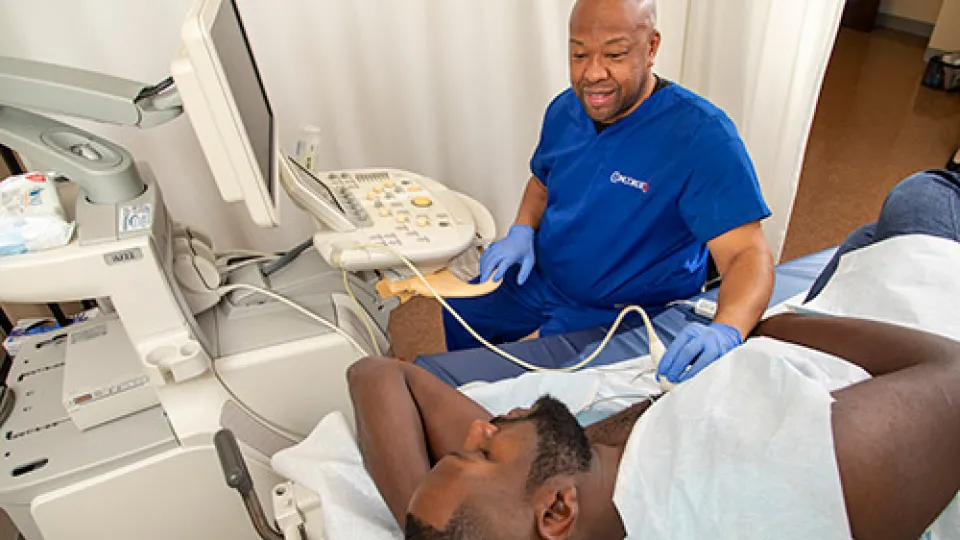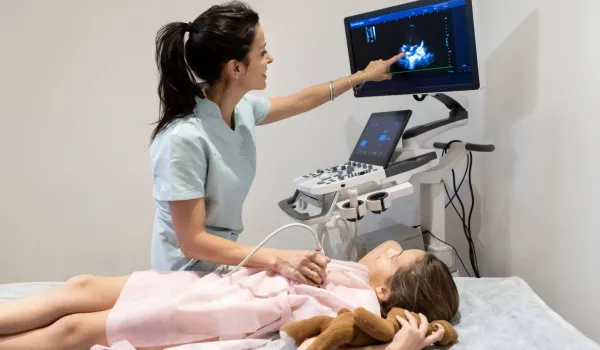Concorde Staff

Sonographers are essential healthcare professionals who operate ultrasound equipment, which uses high-frequency sound waves to create detailed images of internal organs and bodily structures. With over 70 years of medical use, ultrasound technology is a vital non-invasive technique for diagnosing and treating medical conditions. Known by various titles, including Diagnostic Medical Sonographer and Ultrasound Technician, sonographers combine technical proficiency with compassionate patient interaction, maintaining their skills to keep up with advancements in the field.
What Does a Sonographer Do?

Diagnostic medical sonographers play a crucial role in healthcare by utilizing advanced technology to create detailed images of the body's internal structures. Their daily responsibilities encompass a range of tasks that ensure high-quality imaging and effective patient care. Here are the key duties of an ultrasound technician:
- Operate specialized equipment: Sonographers use a transducer to direct high-frequency sound waves into patients' bodies, generating real-time images of internal organs and tissues on a computer screen.
- Prepare for procedures: These individuals set up the exam room and medical equipment, ensuring everything is sterile and functioning correctly.
- Position patients: They accurately position patients to obtain the best images, adjusting them to capture clear, comprehensive scans.
- Monitor and analyze images: Reviewing the images during the scan allows them to check for quality and ensure all necessary areas are covered. While they aren't the ones to diagnose patient medical issues, they can analyze images to ensure they accurately capture the condition under investigation.
- Collaborate with physicians: Sonographers provide a summary of the technical findings to physicians, assisting in diagnosis based on the ultrasound images.
- Keep records: They document and maintain accurate patient records and imaging data, ensuring that all findings and procedures are correctly recorded and updated.
- Maintain equipment: Sonographers regularly check and maintain imaging equipment to ensure optimal performance and prevent malfunctions.
Related: Explore "A Day in the Life" of Two Diagnostic Medical Sonographers
Types of Sonographers
Diagnostic medical sonography encompasses a range of specialized fields, each focusing on different aspects of the body. Here's an overview of the primary specialties and some emerging subspecialties:
- Abdominal sonography: This specialty focuses on imaging the organs and structures within the abdominal cavity, including the liver, kidneys, pancreas, and gallbladder. Abdominal sonography helps diagnose conditions such as gallstones, liver diseases, and abdominal masses.
- Breast sonography: This specialty involves imaging breast tissue to evaluate abnormalities detected through mammograms or physical exams. Breast sonographers use high-resolution ultrasound to help detect tumors, cysts, and other changes, often assisting in biopsy procedures.
- Cardiac sonography: Also known as echocardiography, this specialty concentrates on the heart's structure and function. Cardiac sonographers perform tests to evaluate heart valves, chambers, and blood flow and may specialize further in fetal or pediatric echocardiography.
- Musculoskeletal sonography: This rapidly evolving field assesses muscles, tendons, ligaments, and nerves. Musculoskeletal sonographers diagnose injuries, monitor rehabilitation, and guide injections or other treatments.
- Pediatric sonography: This field specializes in imaging the organs and structures of infants and children. Pediatric sonographers often handle cases related to congenital conditions, premature births, and other developmental issues.
- Obstetric and gynecologic sonography: This area includes imaging the female reproductive system and monitoring fetal development. Obstetric sonographers help assess pregnancy health and fetal growth, while gynecologic sonographers help diagnose conditions such as ovarian cysts and uterine fibroids.
- Vascular sonography: This specialty looks at the blood vessels and circulatory system. Vascular technologists help evaluate blood flow and detect issues such as blood clots, arterial blockages, and other vascular conditions.
- Neurosonography: Crucial for diagnosing neurological conditions and monitoring brain activity, this specialty images the brain and nervous system using advanced techniques such as transcranial Doppler.
There are also a few emerging sonography specialties, including:
- Musculoskeletal sonography for sports-related injuries: This emerging subspecialty addresses the increasing need for detailed imaging of sports injuries, allowing for better diagnosis and treatment of musculoskeletal trauma.
- Neurosonology: Advances in neuroimaging techniques continue to enhance the ability to diagnose and monitor neurological disorders through sophisticated ultrasound methods.
Related: 10 Reasons To Train for a Career in Cardiovascular Sonography
Education and Training

These learning programs and training requirements may help you pursue a career as a sonographer:
- Degree programs: An associate degree or a post-secondary certificate in diagnostic medical sonography is typically required, and these programs may last two to three years. Coursework includes anatomy, medical terminology, and applied sciences.
- Certification: Certification through the American Registry for Diagnostic Medical Sonography is common and involves passing relevant specialty exams.
- Ongoing education: Continual learning is essential to stay current with advancements in the field. Additional credentials for ongoing education credits may include those from the American Registry of Radiologic Technologists and the Society of Diagnostic Medical Sonography.
Related: Diagnostic Medical Sonography programs
Career Outlook
Employment for diagnostic medical sonographers and cardiovascular technologists is projected to grow 11% from 2023 to 2033, much faster than the average for all occupations. About 9,400 job openings are expected yearly due to retirements and career changes. According to the U.S. Bureau of Labor Statistics, the aging baby boomer population is driving this growth due to an increasing need for imaging to diagnose age-related conditions, such as blood clots and tumors. Additionally, the rise in cardiovascular diseases is likely to boost demand for cardiac tests and procedures.
Related: Cardiovascular Sonography programs
Skills and Qualities

Key technical skills that may help sonographers advance in this career include:
- Proficiency with equipment: Mastery of ultrasound machines and imaging technology is crucial for producing high-quality images. This involves understanding various scanning techniques and equipment settings tailored to specific diagnostic needs.
- Knowledge of human anatomy and physiology: A comprehensive grasp of human anatomy and physiology allows sonographers to locate and visualize organs, muscles, and bones accurately. This knowledge helps identify abnormalities and select appropriate scanning methods.
- Understanding medical terminology: Familiarity with medical terminology is vital for effectively communicating with healthcare professionals, interpreting findings, and producing accurate documentation. This also ensures that the sonographer captures the right images of the right area.
In addition to technical expertise, sonographers need strong soft skills to excel in their roles. These include:
- Effective communication: Clear and compassionate communication with patients helps ease their concerns and ensure they understand the procedure. Additionally, sonographers must collaborate with physicians and other healthcare professionals.
- Physical stamina: The role often requires manual dexterity and long periods of standing. Physical endurance is necessary to handle the demands of the job efficiently.
- Attention to detail: Precision is critical when performing scans and analyzing images. Sonographers must meticulously examine images to detect and document any abnormalities.
- Problem-solving skills: Sonographers must troubleshoot technical issues and adjust scanning techniques to obtain the best possible images.
- Creativity and adaptability: Adapting to different situations and thinking creatively to overcome challenges is essential for handling complex cases and varying patient needs.
Challenges and Rewards
There are challenges and rewards to consider when pursuing this career, as well as the impact of AI related to this field:
Challenges
Sonographers often face significant physical strain due to the nature of their work. This includes standing for long periods, performing repetitive motions while operating ultrasound equipment, and maintaining awkward positions to capture the necessary images. Research indicates that a high percentage of sonographers experience work-related musculoskeletal disorders.
Sonographers work in environments where they may come into contact with bodily fluids, which carries a risk of exposure to infectious diseases. Although using the proper personal protective equipment and adhering to stringent infection control protocols mitigate these risks, the potential for exposure remains a concern. The job may also be emotionally taxing, especially when dealing with patients who are undergoing diagnostic procedures to investigate serious health issues.
Rewards
Sonographers play a vital role in diagnosing and monitoring various medical conditions. The direct impact on patient care and outcomes can provide sonographers with a profound sense of fulfillment and purpose. The field of sonography offers specialization in areas such as cardiac, vascular, or obstetric sonography. There is also potential for career advancement into roles such as lead sonographer, educator, or manager. These opportunities allow sonographers to expand their skills and knowledge, contributing to career growth and professional development.
Impact of AI
AI technologies are increasingly being integrated into medical practices, including sonography. Advanced AI algorithms may assist in capturing clearer images and identifying potential abnormalities, which may help reduce the physical burden on sonographers and potentially improve diagnostic outcomes. AI systems may also be used for quality control, helping to ensure that the images produced meet high standards. This may reduce the likelihood of needing to repeat scans, which not only improves patient experience but also helps to alleviate some of the physical strain on sonographers.
Conclusion
The sonography profession is expanding rapidly, offering diverse opportunities as its role in healthcare broadens. Technological advancements are enhancing diagnostic capabilities, with innovations such as improved imaging tools and AI playing a key role in this evolution. Sonographers must prioritize ongoing education and adaptability to new technologies to remain effective and provide the highest standard of care. As the field progresses, embracing these developments will be crucial for staying at the cutting edge and delivering exceptional patient outcomes.
Diagnostic Medical Sonographers and Cardiovascular Technologists and Technicians, Including Vascular Technologists : Occupational Outlook Handbook: : U.S. Bureau of Labor Statistics. (2019, September 4). Bls.gov. https://www.bls.gov/ooh/healthcare/diagnostic-medical-sonographers.htm#tab-6
Edwards, C., Chamunyonga, C., Searle, B., & Reddan, T. (2022). The application of artificial intelligence in the sonography profession: Professional and educational considerations. Ultrasound, 30(4), 1742271X2110724. https://doi.org/10.1177/1742271x211072473

Take The Next Step Towards a Brighter Future
Interested in learning more about our Diagnostic Medical Sonography program? We have a Concorde representative ready to talk about what matters most to you. Get answers about start dates, curriculum, financial aid, scholarships and more!






